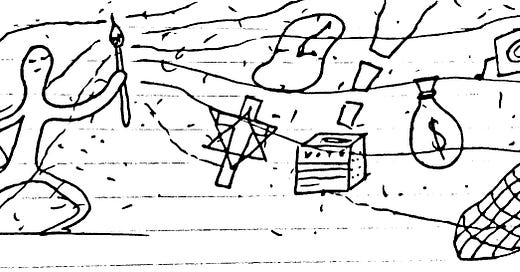Ah, what an age it is when to speak of trees is almost a crime for it is a kind of silence about injustice!
[Bertolt Brecht, “To Posterity,” 1939.]
Between the living and the dead, there are more human beings floating around in this moment than there have ever been before. This number inherently accumulates – the bodies of ghosts stack up, and their numbers increase, always outnumbering that “minority of the living” (as Christopher Isherwood put it in A Single Man).
With all this progress, and all these bodies (corporeal and not), there is more creative output – by volume alone – than there has ever been before. Each post to a global network, each line in a young person’s diary, each instance of joyful dance at a bar – these are artistic acts, however one may judge their aesthetic refinement, and they add up. Although industries are fragmented from each other today, and artistic industries appear to stand alone as islands where all human creative activity is sequestered, this is simply not the case: the nonprofit manager is creative when she drafts her budget, and the computer scientist is artful when he irons out a puzzling bug in the code. Creativity is happening everywhere, and the form of creative expression itself is changing, in response to – and in partnership with – the changes going on in the world.
The world has always been changing, whether for better or for worse. History, like the weather, moves in pressure waves. Droughts are followed by hurricanes, which are followed then by periods of fair weather. As the poet Franny Choi puts it, the world keeps ending, and the world goes on. Fascists get elected when they rally people around a promise. They share their power with loyals. Then they lose their power. And so it goes.
As the seasons of history turn over into one another, the fact of human creativity remains constant, but the form of creative expression changes. It changes when artists ask, “Is making art worthwhile during times of collapse? (Is this a time of collapse?) Will this art help a child scarred by the sickness of the natural world ‘make a difference’?”
In seeking to understand what art “is for,” I come up with more questions than I do answers. But questions form the basis for dialogue, and dialogue – even when it’s not conclusive – can move collectives toward understanding. So, in this essay, I hope to help both you and I understand what art is for, and if it changes during times of crisis. (Is this a time of crisis?)
Cave paintings seem as good a place as any to begin – so what are they for? Considering that these works are ten thousand years away from any extant textual record of a person’s thoughts and feelings, it’s likely that we’ll never truly know. But we can speculate.
These paintings arise in spaces where indentations in rock make apparent an animal form, which, perceived by the cave-painter, can be brought to others via a clever application of pigment. Maybe these ancient paintings were for shamanistic purposes, or were meant to provide visual support to stories told, or were a written record of animals successfully hunted; who are we to say? The only certain conclusion here is that these paintings are representations of real things: paintings of mammoths represent mammoths, and renderings of bison represent bison. The forms of hands imprinted on the walls of the Pech Merle in the South of France are absolutely hands – hands which seem to say, “I have been here.”1
The impulse to record seems to be an ongoing impulse – in visual art, the rise of the camera marked the end of a journey toward representational paintings, as artists no longer needed to be gifted in naturalism to record reality. The camera records things as they are, so artists moved toward other modalities of representation. Take for example the rise of impressionism in the 19th century, or the rise of cubism and surrealism in the 20th century.
So, to sum this point up – one historical function of art is to record the goings-on of the world; it’s a means for humanity to archive its sense experience. The artist, through technical skill, paints a landscape in an attempt to capture its majesty. Viewing the landscape, the audience is filled with awe: and thus, the archival art makes permanent a fleeting feeling granted by natural beauty.
But what if the artist has another intention, one that’s not archival, but about activation – about organizing a group of people toward action?
It is my belief – and this was instilled in me by an art history professor in college – that all art is inherently political, for it arises out of a political context. Apolitical art, as theatre writer and scholar Bertolt Brecht put it, is really just art aligned with the dominant politic of its era.
For art to be “unpolitical” means only to ally itself with the “ruling” group.
[Bertolt Brecht, A Short Organum for Theatre, 1949.]
But some works of art are especially engaged in the task of trying to get groups of people to organize and move toward action. In Waiting for Lefty by Clifford Odets – a 1935 play about cab workers on labor strike – audience plants respond aloud to key moments to incite the rest of the audience to respond in kind.
More recently, Catarina and the Beauty of Killing Fascists, a Portuguese play written and directed by Tiago Rodrigues, has been successful for the same reason. The play has been extensively covered for its explosive memorability – and for its ability to engineer a moment where it feels as if real violence might break out.
Here’s a quick summary, for the uninitiated: it’s the near-future, and a family meets every year at a special retreat place to murder a Portuguese fascist. It is a tradition inspired by the 1954 murder of an ancestor – the activist Catarina Eufémia. One young daughter has just come of age and now it’s her turn to kill the government official the family has kidnapped. But she can’t pull the trigger. Beautiful philosophy pours out as the family negotiates with this daughter – and ultimately she cannot find the violent act in herself, and because of this, the whole family ends up dead. The fascist official escapes, and the play concludes with a filibuster he delivers about bringing authority back into the country and putting women “back in their rightful place,” among many other subjects covered.
The most fascinating aspect of his monologue is the way it manages to engage spectators. Whether through audience plants or some other means, the production jeers the audience into heckling the actor playing the fascists official. As I watched the show – the weekend after the 2024 US election – the audience began to shout: “get off the stage!” and so on. One audience member suggested to the crowd, “I don’t think this stops until we leave.” Another audience member looked like they were about to rush the stage – and security from the theater moved into place to prevent this. I found myself speaking to spectators around me, trying to sort out what to do – we the audience were no longer spectators, but in conversation with one another. The play develops democratic movement in its audience – an outstanding accomplishment in theatre – and in a moment of self-awareness, hands the keys of politics to us. The play’s themes about political acts of violence and the tensions it represents between resistance, ambivalence, and compliance are made personal: watch, or don’t watch. The choice is yours.
The conversation around the political ethos of art was probably first brought to my attention by Diane Farbiarz, an AP English Language teacher at my public high school (I had her for a half-year, before she retired to the Pacific Northwest). Farbi was a teenager in the 60s and a young adult in the 70s; so, as a teacher of rhetoric, she really pushed us students to be aware of the way language is always working to do something to us as we read it. Language, in this age, is often selling something, whether that’s a product or a point-of-view. Thought shapes action, so a political point-of-view which is sold – even if it’s only a temporary frame, a fragment – can become a less-than-temporary vote (or abstention).
Farbi was burnt out. And that’s how I remember her: as a child of the 60s and the 70s who feels that she and her generational peers tried their best to organize collective action, but didn’t change the world. Not in every way they’d hoped.
Returning to the question we set out to explore in this essay – what art “is for” in a changing world – and in light of the context we have thus explored, it might be fairly concluded that one of the purposes of art (if art can be called purposive) is to convey truth to power. Power resists truth, especially when that truth is disquieting to a class of person who holds power and is thus comfortable. So how does art do this?
To take a page from Immanuel Kant’s book, maybe we can begin by considering the conceptual, a priori, aesthetic question. In what form must artistic creations be presented in order to communicate, connect, and affect across the power-forces of money, class, religion, global networks, law, and war? And if art does that – if it pierces those fortresses of power – what does it need to say?
Perhaps betraying the promise in this piece’s introduction, I leave these as open questions, to which I have no answer. I hope only to continue to explore these avenues, through fragments here and through more conversation – in words which begin without knowing, and search for the glimmer of awareness.
Smith, Justin E. H. “What Cave Art Means.” 1 September 2018. Art in America.





